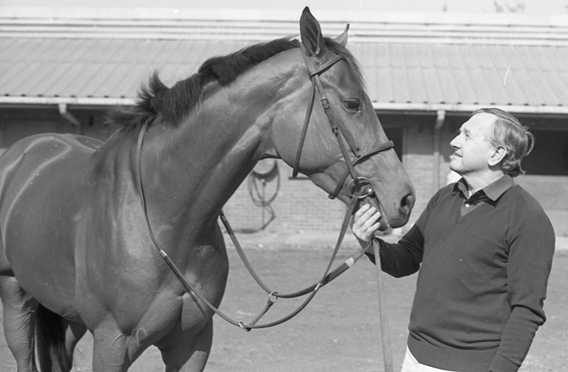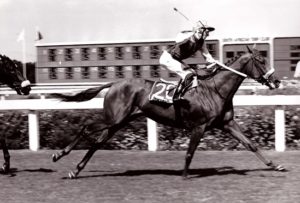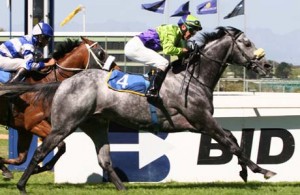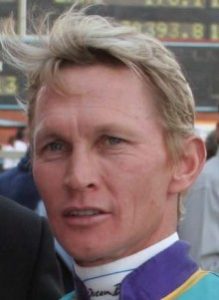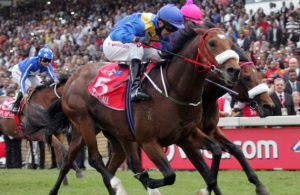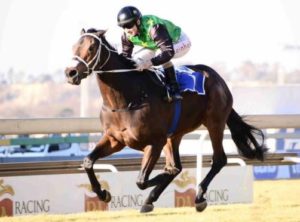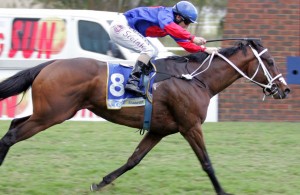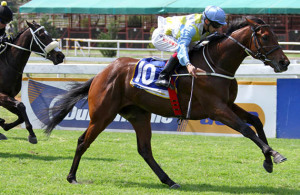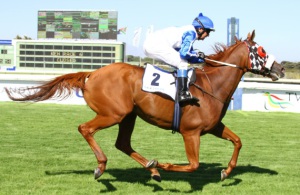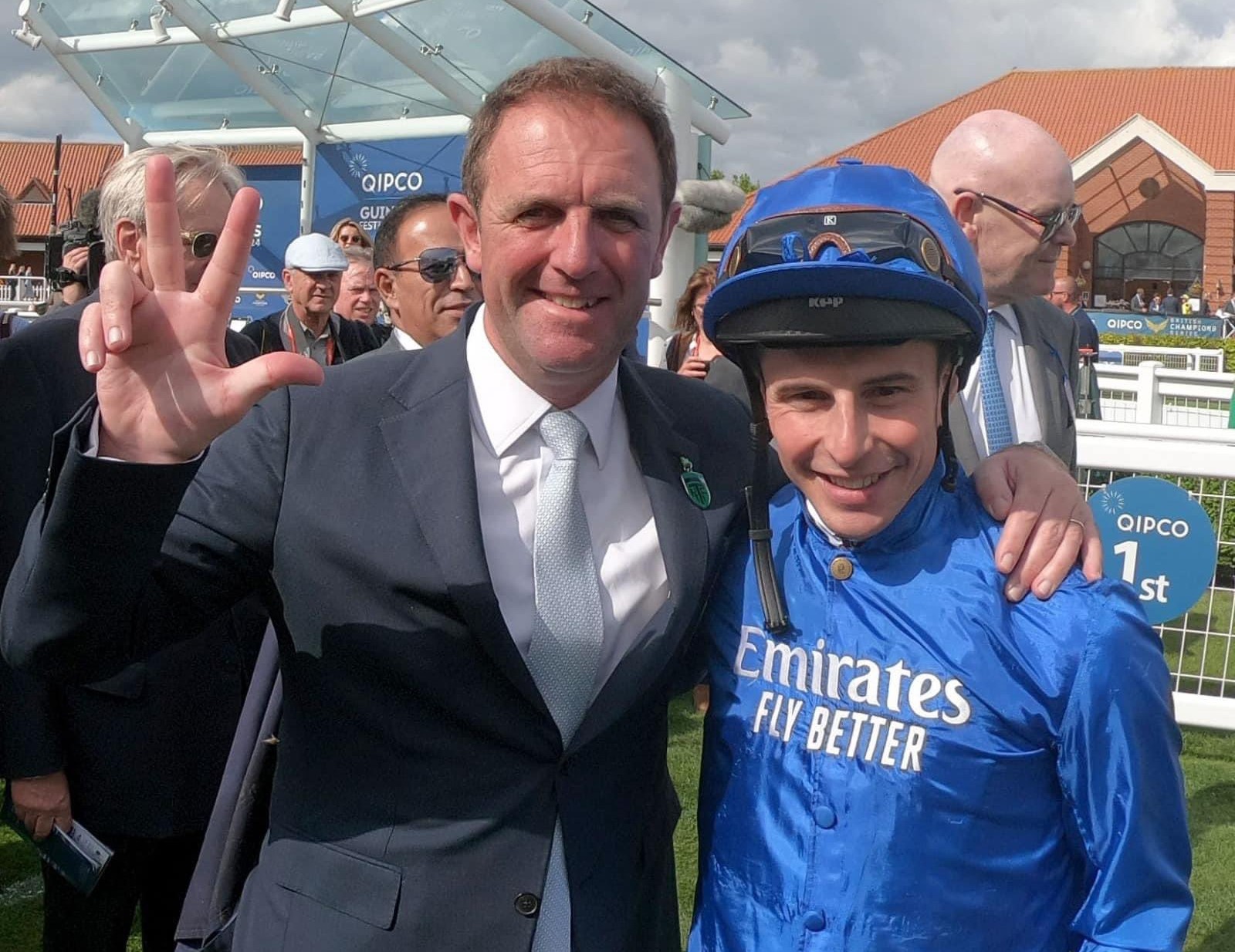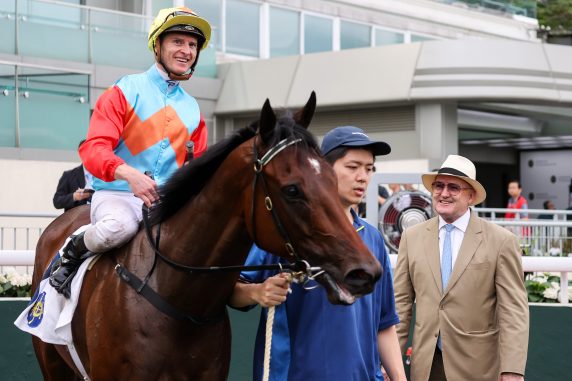“Owners must understand that sometimes you’ll have to make a sacrifice, and their horse is used to make the pace for others. There will be pay-back for them some other time.” That more or less sums up the approach of champion trainer Terrance Millard, who more often than not fielded a bunch of runners in big races in the ‘Eighties’, writes Karel Miedema.
The idea was to make sure the races were true-run, so that the best horse at the weights would win. His horse mostly!
Things didn’t always go to plan when the money was down.
Millard runners would fill the frame, but sometimes the wrong ‘un won.
Remember 1986 July-favourite Fool’s Holme being beaten by stable-mate Occult?
Bartie Leisher cruising in front on the latter, at a comfortable gallop, ignoring the mid-race urgings of the favourite’s rider Felix Coetzee to step it up. Stepping it up he did, but only when coming into the straight, simply outrunning the rest. Good old Bartie.
Have a look – it should bring back some memories!
In 1989, Right Prerogative’s win on a rain-sodden track was another case of the wrong horse. Fellow-trainer (and brother-in-law) Ralph Rixon watched the race with Terrance. After they crossed the line Rixon said in disgust ‘wrong horse won’ (meaning it should have been his horse Tropicante). “I know!”, Millard said equally ruefully, meaning his runner Violero…
Next to weight, pace is the great leveller in the outcome of races. Too fast early, and those from behind have an edge. Too slow early, and anything can happen – the ones who quicken best have the edge. Pace just right, you’ll have to be handy to have a shout.
Some big-race examples from times gone-by make it easier to grasp.
Wainui won a fast run Queen’s Plate (WFA) from nineteen opponents, in record time, the first filly to win the Cape’s flagship mile in 50 years. Jungle Warrior finished 3 lengths behind her in third. Wainui again topped the boards at her next start, in the J&B Met, over 2000m. That was a conditions race, where she was some 4kg better off with Jungle Warrior on their Queen’s Plate run.
Wainui set off at a furious pace, the first 1000m in 59 seconds, a sprinter’s pace. Not surprisingly Wainui had little left when it mattered, Jungle Warrior coming from off the pace to beat her by two lengths into third (Aquanaut was second, stamina mattered).
Pocket Power at Clairwood, in the Gold Challenge (WFA) over a mile. He was 15/10 favourite in a field of ten, Smart Banker second favourite at 33/10. Pocket’s stable companion Blue Tiger did front runner duty. He did it well, setting a solid, even pace from the jump.
Unfortunately the rest of the field, bar Big City Life in close second, didn’t follow and Blue Tiger had them properly strung out.
In the end Big City Life nailed Blue Tiger on the post. The winning time was as fast as they go the mile at Clairwood. Pocket Power had simply been too far back, and would have needed wings to catch up.
You can give weight, but you can’t give start, as they say. Or: there’s nothing as hard to beat as a front runner who doesn’t stop.
And then there is Futura. Winner of this year’s Queen’s Plate and J&B Met. Both races run at a crawl early on, with Futura’s amazing ability to accelerate carrying the day. Such races are a nightmare to assess properly. Who knows what could have happened had the pace been true?
Understanding the effect of pace is nothing new. Here’s a favourite passage from Federico Tesio’s ‘Breeding The Racehorse’, written some seventy years ago.
Let us give a practical example by comparing two horses, X and Y.
X has a maximum speed of 5 furlongs in 1.01 minutes, and 1 mile in 1.39 minutes.
Y has a maximum speed of 5 furlongs in 1.00 minutes, and 1 mile in 1.42 minutes.
It is obvious that if these two horses are matched over 5 furlongs the winner should always be Y, while over the mile the winner should always be X.
But supposing that the jockey who is riding X over the mile should happen to hold his mount back a little at first so that he would run the distance in 1.43 instead of his possible 1.39, this might enable his rival Y to pass him and win in 1.42.
This is the kind of mistake jockeys frequently make in a race, because they do not realize that the distance should not be measured with a yardstick but with a stop-watch, or by the time it takes to cover it. The successful jockey is the one who is the best judge of pace – the pace being the time it will take his horse to cover a certain distance.
In an important race, the owner of a good horse which has been perfectly conditioned for the distance will always try to enter another horse ‘to set the pace’, in other words to ensure the fastest pace possible. Thus a rival horse whose speed is limited to shorter distances will not be given the chance of winning by a sudden sprint.
It frequently happens, however, that a trainer has not entered a second horse good enough to set the pace for his favourite (by good enough we mean a horse that others in the race must follow closely, or risk being unable to overtake before the finish). In this event his favourite must set the pace himself.
Bartie Leisher’s July post-race interview with Martin Locke is worth watching!
To be in front and force the pace has its disadvantages, for the leading horse must act as a wind-breaker which involves greater effort, while those who follow in his wake tire less easily. Between the two evils one must always choose the lesser, so in the absence of a pacemaker it is safer for a trainer to take the lead with his favourite, provided he is convinced that his horse can ‘stay’ the distance best, in other words that he can cover the whole distance in the fastest time.”
(Tesio’s writings on breeding and racehorses give great food for thought – Amazon still has copies available of the old book).
After the lack of pace in this year’s Queen’s Plate and J&B Met (and last year’s Vodacom July for that matter) there are unanswered questions.
Like which horses are best, and how true are the official handicapper’s ratings (based as they are on those slow run races). Perhaps a true-run 2015 Vodacom July can give answers. Let’s see what the pace might be like by looking at this year’s runners and their normal pattern of racing.
The July-draw shows in brackets next to each horse’s name.
Futura (6) – Relatively lightly raced, the 4yo has never been out of the first four in fourteen lifetime starts. Eight of those starts were in false run races, highlighting his ability to accelerate off a less than true pace. His record shows that he can race handy as well as come from off the pace, both in true and false run races. He was handy in last year’s (slow run) July, keeping on well, beaten under a length in third.
Wylie Hall (2) – Lost last year’s July on objection, having raced handy. His record shows him to be equally effective from off the pace as well as close to it, in true as well as false run races.
Majmu (1) – Last season’s champion 2yo filly has shown she’s equally adept at racing handy or from off the pace. She has yet to encounter a false run race. She goes beyond a mile for only the second time in her career, but on pedigree should relish the July distance. Her most recent efforts were from a handy position.
French Navy (10) – Not always a quick beginner. All of his races bar one show him to have raced from behind – the one exception was a false run 1800m at the Vaal, where he just got up to win, but recording a rating well below his best. He seems likely to come from behind again, and will need a true run race.
Legal Eagle (11) – Quoted at very long odds when the July ante-post betting opened, looking a seemingly optimistic entry based on his ratings to date. Subsequently won false-run SA Derby by a 3 lengths from Deputy Jud. Showed his true colours next time out, in very fast run Jubilee handicap over 1800m, improving on his rating out of all recognition in what was his seventh lifetime start. That was after publication of the weights for the July, and consequently he carries 3kg less in the race than he should have, based on his last run. His normal style of running is from off the pace. He’ll need a true run race.
Pine Princess (5) – Her usual style of running is handy, but she has shown herself to be equally effective from off the pace, as she did in the (slowish run) SA Oaks. Set a sedate pace at her most recent start in the Woolavington 2000 at this track, being mugged on the post by Smart Call, with the rest well beaten, running to her best rating. She seems likely to race handy again, possibly to help ensure a decent pace for her stable companion Majmu (who is in different ownership).
The Conglomerate (20) – Lightly raced, has improved since coming to Durban this year, racing handy with Marcus up in true run races up to 2000m. In prior runs he’d done well held up, but against lesser opposition. Drawn widest of all.
Gold Onyx (18) – If ever a mascot is needed for the Crazy Horse Saloon, he is it.
The seven-year-old will be making his 50th career start here. He has been ridden during his career by Guillermo Figueroa, Felix Coetzee and Kevin Shea, outstaying all of these now retired jockeys. Contested the July in 2012, when less than 3 lengths behind the winner in 7th, after a hampered start. Ran in the July consolation race the next two years (both times in third, beaten less than 2 lengths). Fully deserves another crack at the Big One, following amazing efforts in the two-mile Gold Cup (beaten half a length in 3rd), and the false run Queen’s Plate (3rd) and J&B Met (2nd) this year. Can go handy as well as be held up, in both true and false run races.
Power King (7) – Not always a quick beginner. Invariably races from off the pace.
Deputy Jud (15) – Runner-up, beaten 3 lengths, in false run SA Derby won by Legal Eagle, and here in receipt of just 1kg. Can be held up as well as race handy (set pace when winning 2nd start). Raced handy in four of his last five starts.
Halve The Deficit (14) – Finished 4 lengths seventh in last year’s slowly run July (Strydom up), never nearer in the running. Has scored the majority of his wins after racing handy, but seems equally effective held up.
Dynastic Power (13) – seems to be able to go handy as well as be held up to produce his form, but isn’t always a reliable beginner. Stays well, and should prefer a good pace here – which also goes for his stable companion Punta Arenas. Will probably go handy if he jumps, although the draw does him no favours.
Tamaanee (16) – This 3yo filly has raced handy (once making the pace) at her last four starts, but has been equally effective held up, both in true and false run races.
Tellina (3) – Finished just under 2 lengths in fourth in last year’s false run July. There seems to be no real pattern to his style of running, but he seems equally effective handy as held up. His performances in false run races (notably the Queen’s Plate and J&B Met this year) suggest that he might benefit from a good pace, rather than having to accelerate off a slow pace.
Punta Arenas (19) – This will be the gelding’s third July in as many years. He went handy from a wide draw at the first of those, running some way below best. He was held up in a slow run July last year, running on for 6th (beaten 4 lengths). He has shown his best form both racing with the pace and off it. His last two runs, including an impressive Cup Trial win, were after being held up in true run races. He seems likely to be ridden that way again. His run in this year’s Met suggests he lacks immediate acceleration off a slow pace, and will need a good pace here.
Ice Machine (12) – Notoriously slow beginner. Invariably races from off the pace. Has recorded his best ratings in true run races.
Dynamic (17) – Lightly raced 5yo. Not always a reliable beginner. Seems effective held up as well as handy (set the pace in false run Premiers Trophy, running on well). Has yet to show to stay a true run 2000m (had false run Cape Derby and Met at only tries). Was first reserve runner at final field announcement.
Helderberg Blue (8) – Set the pace in this year’s false run J&B Met, to finish third, 2 lengths off winner Futura and level with Gold Onyx in second. Is 4.5kg better off with Futura and 1kg with Gold Onyx on that run. Goes well handy, but also was effective held up earlier in career (when not always a reliable beginner). Raced handy at last start, when 2 lengths 4th in Cup Trial, posting a career-best rating. Ought to race handy again, but there could be a stamina-doubt, so perhaps a modest early pace in the race might suit him best.
Hot Ticket (9) – Notoriously slow beginner. The only occasion he’s ever raced handy (in over 20 starts) was in last year’s KZN Derby (or equivalent name), which earned him a career-best rating. Narrowly beaten at last start in 2015 KZN Derby, coming from off the pace in a race run at a crawl.
Mac de Lago (4) – Lightly raced 3yo, who improved dramatically at his last two starts, after being slow away both times, forcing him to race from off the pace. Was second reserve runner at time of final field announcement.
In summary, there’s a bunch of horses who are likely to race handy, but there’s no real front runner present.
So it’ll be up to the trainers with more than one runner to apply the Millard-principle and make the sacrifice.
Only then are we likely to have a true-run race, and true result.


